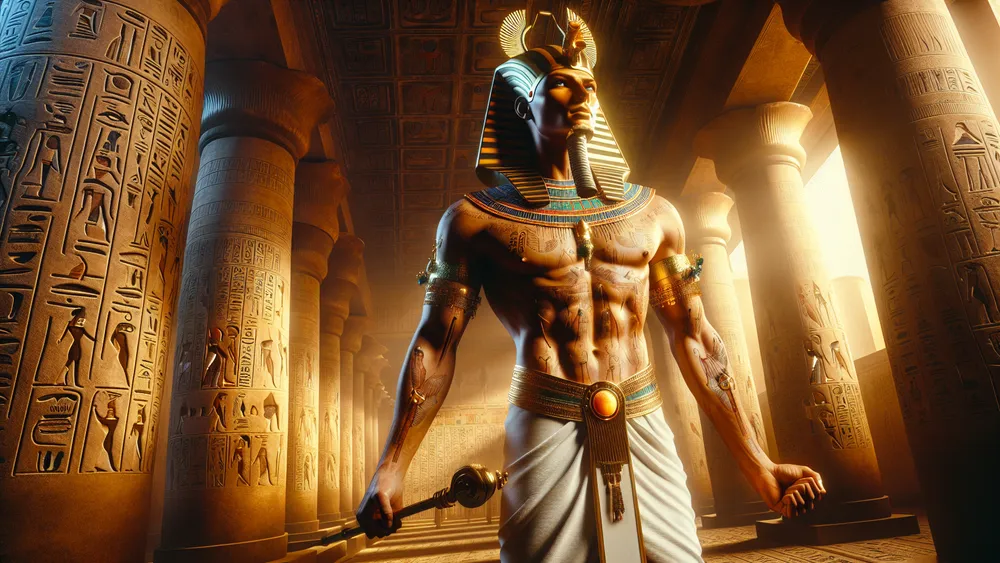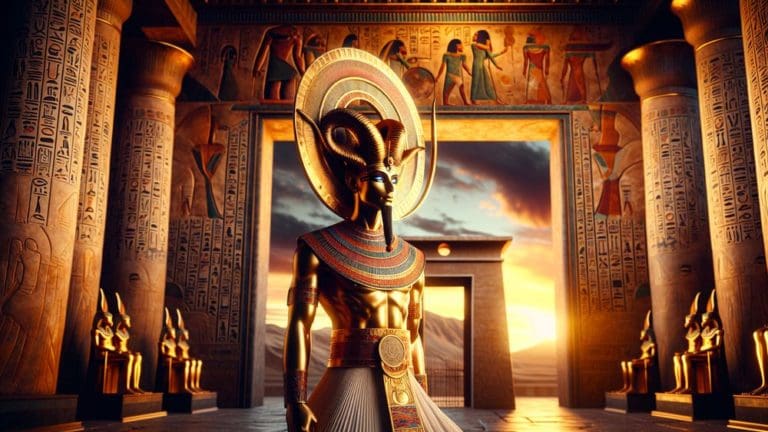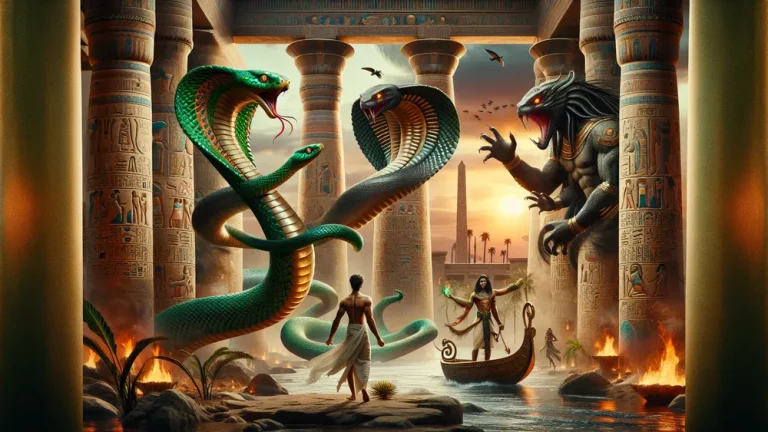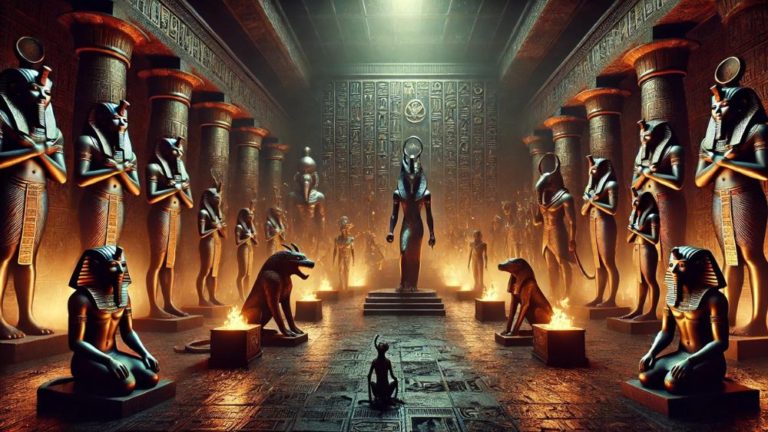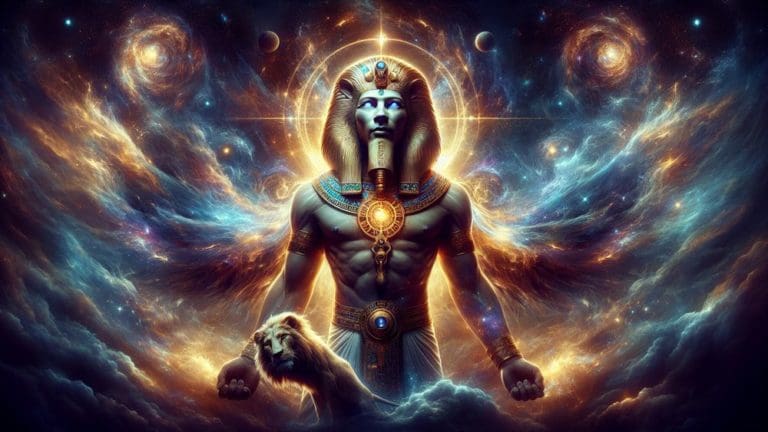Osiris: Egyptian God Of Fertility And Resurrection
Osiris is one of the big names in ancient Egyptian mythology. He’s the god of fertility, resurrection, and the afterlife. His story? It’s all about life, death, and coming back to life. So, he’s a pretty big deal in ancient Egypt’s religious and cultural practices. In this blog post, we’ll dive into where he comes from, what he does, and the myths around him.
Key Points:
- Osiris is the Egyptian god of fertility, resurrection, and the afterlife.
- Osiris’s family includes siblings Isis, Set, and Nephthys, and his parents are Nut and Geb.
- Osiris’s story involves his death and resurrection, symbolizing hope and rebirth.
- Osiris judges souls in the afterlife and is central to Egyptian burial practices and morals.
- Osiris is often symbolized by the crook and flail, the Atef crown, and green or black skin.
- Worship of Osiris involves temples, daily offerings, and festivals like the Khoiak festival.
- Osiris’s influence can be seen in modern media and some contemporary religious practices.
We’ll also look at his symbols, how people worship him, and even how he pops up in modern times. By checking out his ties with other gods, his art depictions, and his modern influence, we get why Osiris still stands as a powerful symbol of rebirth and eternal life.
Who is Osiris?
So, to get why Osiris is such a big deal, we gotta look at where he comes from and who he’s related to. First up, let’s dive into his birth and how he connects with other gods.
Origins and Family
Osiris, a big name in Egyptian mythology, comes from the sky goddess Nut and the earth god Geb. He’s got quite the family. There’s his siblings: Isis, Set, and Nephthys. Osiris and Isis? They’re not just siblings; they’re also married. Together, they have a son named Horus.
Set, his brother, isn’t just any sibling; he’s the one who causes Osiris a lot of trouble, eventually leading to his death. Horus, their son, steps up to avenge his dad and keep his story going. This family mix is key to getting how all the gods’ stories fit together in Egyptian mythology.
- Nut and Geb: Parents of Osiris, representing the sky and earth.
- Isis: Sister and wife of Osiris, known for her magical abilities.
- Set: Brother of Osiris, known for his role as the god of chaos and violence.
- Horus: Son of Osiris and Isis, often depicted as a falcon-headed god.
Osiris, Isis, Set, and Horus form a crucial family dynamic in Egyptian mythology, where relationships and actions intertwine to influence the stories of the gods.
Role in Egyptian Mythology
Osiris is a big deal in Egyptian mythology. He’s the god of fertility and resurrection. People see him as the reason the Nile River floods every year, bringing rich soil that helps crops grow. This flooding is like Osiris’s way of making sure everyone has enough food. And then, there’s his story of dying and coming back to life. It’s a huge symbol of hope.
When Isis and Nephthys bring him back after Set kills him, it shows how life can start again after ending. In the afterlife, Osiris is super important. He’s the judge of souls. There’s this ceremony called the Weighing of the Heart. They weigh your heart against the feather of Ma’at, who stands for truth and justice.
If your heart is lighter, you get to live forever in the Field of Reeds. If not, Ammit, this scary creature, eats it. This whole belief shapes how Egyptians think about life and death. It makes them want to live truthfully and justly. Osiris’s story and role affect everything from burial practices to everyday morals.
- Nile River Flooding: Seen as a manifestation of Osiris’s power.
- Weighing of the Heart: A critical ceremony in determining the fate of souls.
- Field of Reeds: The ideal afterlife destination for worthy souls.
- Ammit: The creature that devours unworthy souls.
- Moral Code: Emphasized truth and righteousness among Egyptians.
The Myth of Osiris
To get why Osiris is such a big deal in Egyptian mythology, you gotta dive into the story of his death and resurrection. This myth shows his importance and explains a lot of the rituals and beliefs around him.
The Death and Resurrection of Osiris
So, the story of Osiris’s murder starts with his brother, Set. He’s super jealous of Osiris being king. Set comes up with this sneaky plan to get rid of him. He makes a fancy chest and says whoever fits in it perfectly can have it. At a big feast, everyone tries, but only Osiris fits.
As soon as he’s inside, Set and his buddies seal the chest and toss it into the Nile River. The chest floats away and gets stuck in a tamarisk tree in Byblos. That’s how Osiris dies, hidden inside the tree that grows around the chest. Isis, who’s Osiris’s wife, goes on a mission to find his body.
She gets help from her sister Nephthys, and they find the chest and take Osiris’s body back. But then Set finds it again and cuts it into fourteen pieces, scattering them all over Egypt. Isis and Nephthys don’t give up. They gather all the pieces except one, which a fish eats.
Using her magic, Isis puts Osiris back together and does rituals to bring him back to life. He doesn’t come back fully alive but becomes the ruler of the underworld. His resurrection shows the cycle of life, death, and rebirth, which is super important in Egyptian culture.
- Set’s Jealousy: Motivated by envy and desire for power.
- Isis’s Quest: Demonstrates loyalty and determination.
- Dismemberment: Represents chaos and fragmentation.
- Reassembly by Isis: Symbolizes restoration and healing.
- Ruler of the Underworld: Osiris’s new role after resurrection.
Osiris’s murder by Set, his resurrection by Isis, and his role as ruler of the underworld symbolize key themes of Egyptian culture.
Osiris and the Underworld
Osiris is super important in the Egyptian underworld, called the Duat. He’s the god of the afterlife and judges souls. When someone dies, their soul goes on a journey through the Duat, facing all sorts of challenges. The big moment is the “Weighing of the Heart” ceremony. Osiris is there, watching. They weigh the person’s heart against the feather of Ma’at, who stands for truth and justice.
If the heart is lighter, it means they lived a good life, and they get to go to the afterlife. But if it’s heavier, Ammit, a scary creature that’s part lion, hippo, and crocodile, eats it. This shows Osiris is fair, only letting the good ones into the afterlife.
| Aspect | Details |
|---|---|
| Role in Underworld | Presides over judgment of souls |
| Weighing of the Heart | Ceremony to determine the righteousness of the deceased |
| Feather of Ma’at | Symbolizes truth and justice |
| Outcome for Righteous | Access to the afterlife |
| Outcome for Unrighteous | Heart devoured by Ammit, resulting in eternal damnation |
Symbols and Iconography
So, we’ve talked about Osiris’s role in mythology, but that’s only part of it. His symbols and how he shows up in art are super important too. Let’s dive into the different symbols tied to Osiris and see how he’s been portrayed over time.
Common Symbols Associated with Osiris
Osiris has a bunch of symbols that really mean a lot in Egyptian art and culture. You often see him with the crook and flail. The crook is like a shepherd’s staff, showing kingship and guidance, while the flail, which they used in farming, stands for fertility and providing for the people. Another big one is the Atef crown.
It’s a white crown with two ostrich feathers on the sides. This crown shows his power over the afterlife and his role as a judge of souls. These symbols aren’t just for looks; they tell us a lot about Osiris’s roles as a ruler, provider, and judge. They are super important to get what he’s all about in Egyptian mythology.
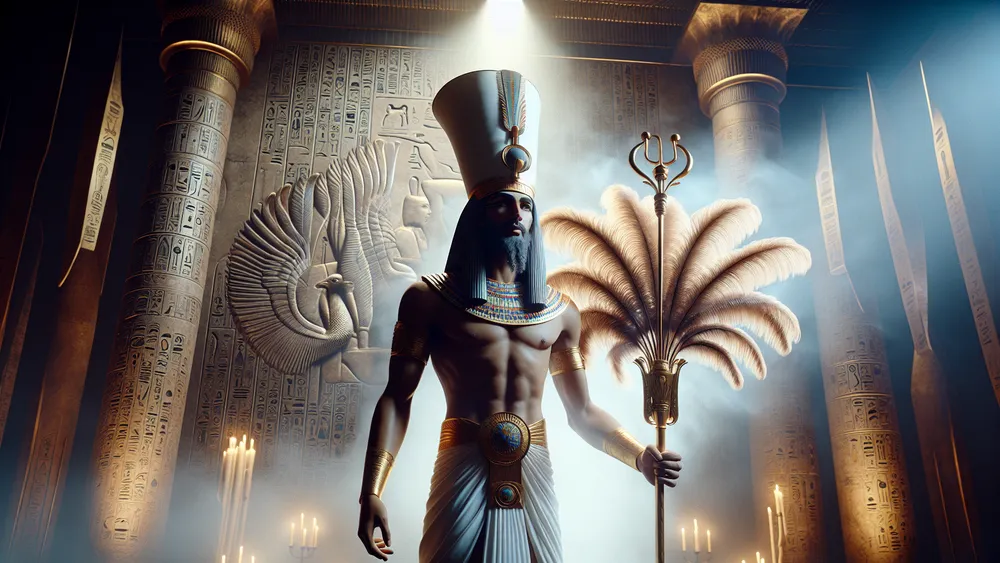
- Crook and Flail: Often crossed over the chest in depictions of Osiris.
- Atef Crown: Frequently seen in statues and carvings of Osiris.
- Green Skin: Symbolizes rebirth and fertility, often used in depictions of Osiris.
- Djed Pillar: Represents stability and is associated with Osiris’s backbone.
Depictions in Ancient Art
Osiris shows up a lot in ancient Egyptian art. You often see him as a mummified figure with green or black skin. This color thing? It’s all about rebirth and fertility. In statues, he usually stands or sits on a throne, holding the crook and flail across his chest. These items show he’s a ruler and a provider. Paintings and carvings?
They often have him wearing the Atef crown. This crown, with its white color and ostrich feathers, screams authority over the afterlife. Over time, his look changes. Early on, it’s pretty simple, just the basics. But later, it gets more detailed and fancy. They start adding stuff like the Djed pillar, which stands for stability and links to Osiris’s backbone.
- Green or Black Skin: Symbolizes rebirth and fertility.
- Atef Crown: Indicates authority over the afterlife.
- Crook and Flail: Signify kingship and provision.
- Djed Pillar: Represents stability and is linked to Osiris’s backbone.
- Mummified Form: Highlights his association with death and resurrection.
The symbols in ancient Egyptian art represent different aspects of Osiris, such as rebirth, authority over the afterlife, kingship, provision, stability, and his association with death and resurrection.
Worship and Festivals
So, we’ve talked about the symbols and how Osiris is shown in art. Now, let’s dive into the temples and worship practices. We’re also going to look at the festivals that celebrate this important god.
Temples and Worship Practices
Osiris has some pretty famous temples, like the Temple of Abydos and the Temple of Philae. These places are where people go to worship him. They do all sorts of things there. For example, they make daily offerings of food, drink, and incense. This is supposed to keep Osiris happy in the afterlife. Priests also perform elaborate ceremonies.
They read from the Book of the Dead and other sacred texts. Sometimes, they even do processions and reenactments of Osiris’s story, especially his death and resurrection. This is to make sure the land stays fertile and life goes on. People also leave votive offerings like small statues or amulets in the temples. They hope Osiris will give them protection and prosperity.
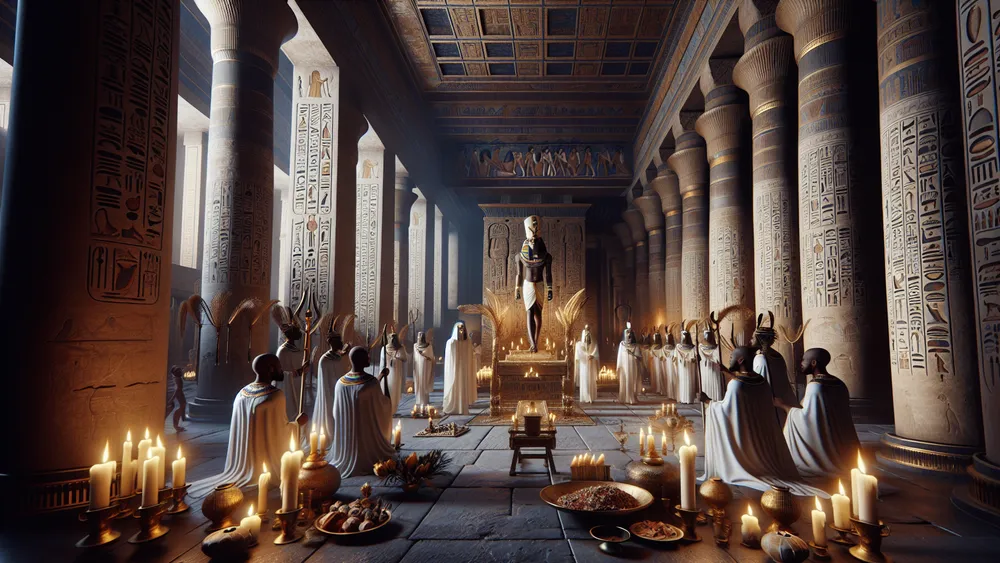
- Temple of Abydos: One of the most important places for Osiris worship.
- Temple of Philae: Another big temple for Osiris, known for its beautiful architecture.
- Daily Offerings: Bread, beer, and incense to honor Osiris.
- Book of the Dead: Sacred text read during rituals to call on Osiris’s powers.
- Votive Offerings: Small statues or amulets left by people seeking blessings.
Festivals Celebrating Osiris
One of the big ones for Osiris is the Khoiak festival. It happens during the month of Khoiak in the old Egyptian calendar. This festival is all about rituals that show Osiris’s death and coming back to life. It’s a big deal because he’s the god of fertility and renewal. People make these things called Osiris beds.
They’re small effigies made from earth and seeds, and they stand for Osiris’s body. They water these beds so the seeds sprout, which is like Osiris being reborn and bringing new life. Another important thing they do is sow barley seeds in mud figures of Osiris. They put these in tombs to help the dead be reborn in the afterlife.
The festival also has processions, hymns, and dramatic reenactments of Osiris’s story. These activities show how important he is in keeping the cycle of life and death going.
- Osiris Beds: Effigies made from earth and seeds, symbolizing Osiris’s body.
- Sowing of Barley Seeds: Ritual involving planting seeds in mud figures to ensure rebirth.
- Processions and Hymns: Ceremonial activities that honor Osiris and recount his story.
- Dramatic Reenactments: Performances that depict the myth of Osiris’s death and resurrection.
Osiris’s Influence on Modern Culture
Osiris’s legacy goes way beyond ancient Egypt. It pops up in all sorts of modern stuff, from movies to books. Let’s dive into how this old god still resonates in today’s world.
Osiris in Popular Media
Osiris pops up in all sorts of popular media, showing just how much his story sticks around. You see him in movies like “Gods of Egypt” (2016), where he’s a big deal among the gods. Books? Yep, he’s there too. Take “The Kane Chronicles” by Rick Riordan for example, which mixes Egyptian myths with modern tales. And don’t forget video games!
In “Assassin’s Creed Origins”, Osiris is part of the game’s ancient Egyptian world. These stories often focus on his roles as the god of the afterlife and resurrection, bringing up themes of rebirth and judgment. By weaving Osiris into their plots, these media forms keep his legend alive and kicking, showing that his myth is truly timeless.
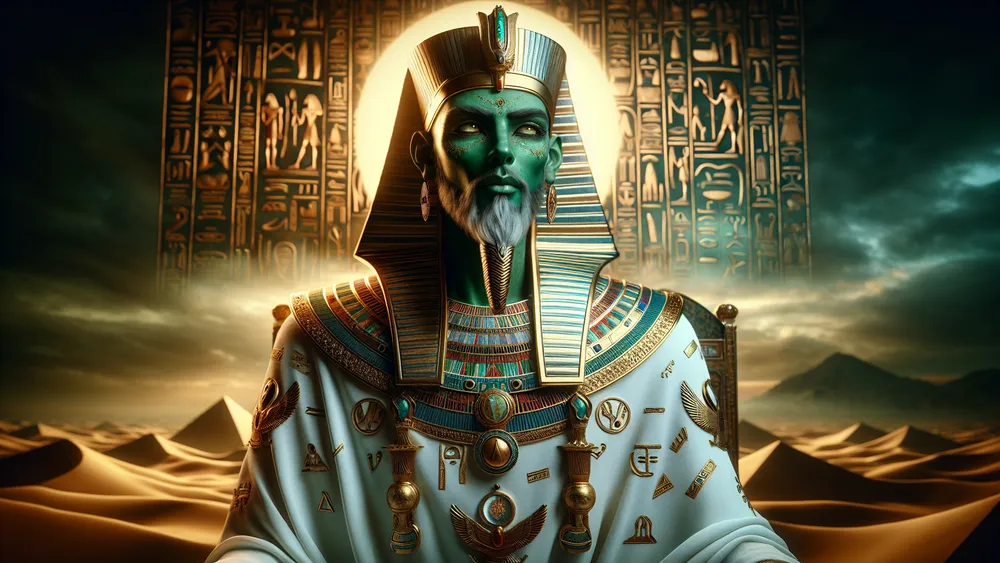
- “Gods of Egypt” (2016): A film that features Osiris as a key character.
- “The Kane Chronicles” by Rick Riordan: A book series that integrates Osiris into its story.
- “Assassin’s Creed Origins”: A video game that includes Osiris in its depiction of ancient Egypt.
- Themes of Rebirth and Judgment: Common elements in modern portrayals of Osiris.
Modern Religious Practices
Today, some folks still venerate Osiris, especially those into reconstructing ancient Egyptian religious practices, which they call Kemetism. They often hold rituals and ceremonies to honor him as the god of the afterlife and resurrection. You might see them offering food, drink, and incense to statues or images of Osiris, hoping for his guidance and blessings. His story of death and resurrection?
It’s a powerful symbol of renewal and transformation that really resonates with people today. They often weave this symbolism into their personal spiritual practices, like meditation and seasonal celebrations, to reflect on themes of life, death, and rebirth.
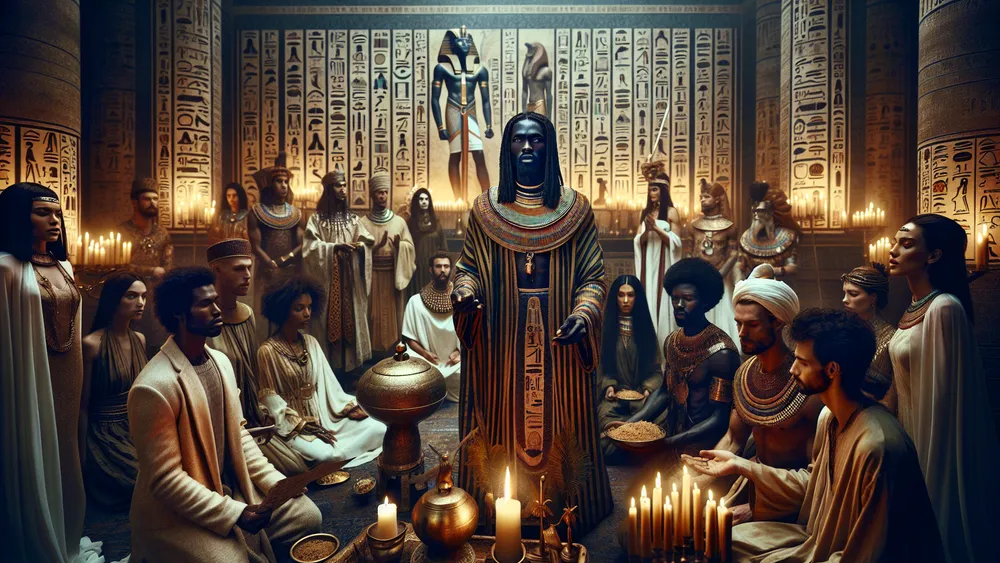
- Kemetism: A modern religious movement that seeks to revive ancient Egyptian beliefs.
- Offerings of food, drink, and incense: Common practices in veneration rituals.
- Renewal and transformation: Key themes in Osiris’s story that are relevant to contemporary spirituality.
- Meditation and seasonal celebrations: Ways in which Osiris’s symbolism is integrated into modern practices.
Pantheon of Egyptian Gods
The pantheon of Egyptian gods? It’s huge and super detailed. There are gods for everything, really. If you want to dive in, check out this list of all the Egyptian gods. It’s got all the major ones, with cool details about their roles and how they connect with each other.
FAQs
1. Who is Osiris in Egyptian mythology?
So, Osiris in Egyptian mythology? He’s the god of fertility, resurrection, and the afterlife.
2. What are the symbols of Osiris?
So, Osiris’s symbols? They include the crook and flail, which he always holds. Then there’s the Atef crown. Oh, and don’t forget his green skin. It stands for rebirth.
3. How did Osiris die?
So, Osiris? He dies when his brother Set tricks him. Set gets him to lie in a coffin and then seals it shut.
4. What is the significance of Osiris’s resurrection?
So, the whole deal with Osiris’s resurrection? It’s all about eternal life and how death isn’t the end but just a part of a cycle. In Egyptian mythology, his story shows that life and death are connected, like a never-ending loop.

